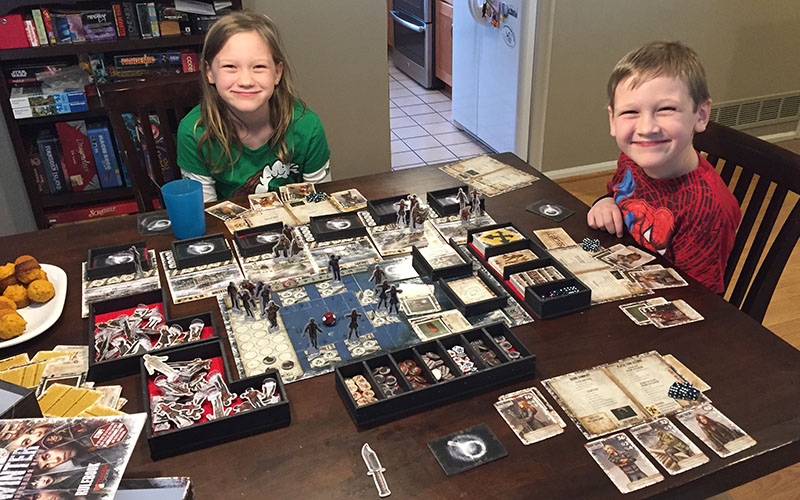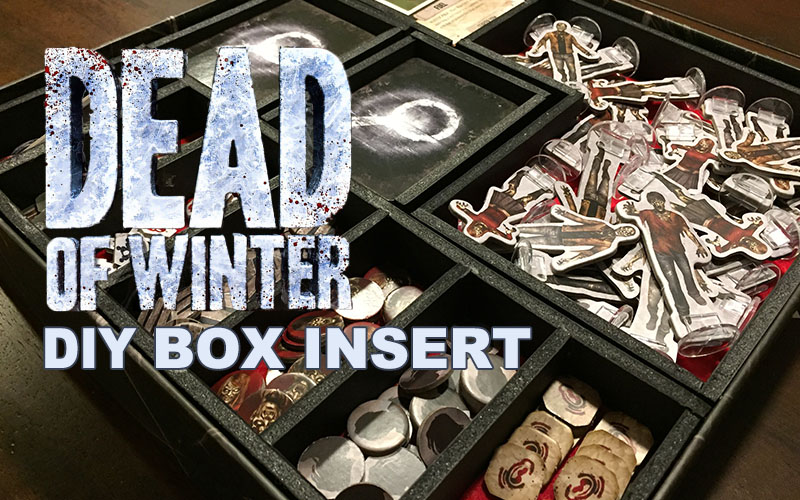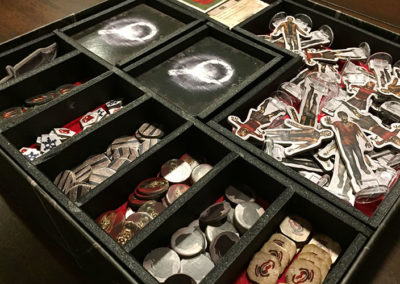Over the past two years, I’ve really gotten into the resurgence of board games and I enjoy playing them with my kids. One of the games we bought that is super fun to play, is Dead of Winter. My kids would want to play a game, but it would take a good 15 minutes to get the game started. The cards were always all mixed up, the little baggies of tokens, all the zombie and survivor standees all mixed up. It was just cluttered and not fun or easy to set up.
Somehow I became obsessed with ways I could organize the box, and I ultimately realized I “needed” to make an insert. Ok… project time!
My Goals
- Improve setup and cleanup time. We want more time to play, less on the boring stuff.
- Keep parts organized while playing. It’s frustrating when little parts are being bumped all over the place during gameplay.
- The function was equal to form. It should be a practical design, but also pretty darn cool too.
Old School
I also had a final main goal: don’t use a computer (other than research). I use a computer almost all day, and I wanted a project where I could use my hands to create something. Pencil and paper design, and hands-on execution. There’s something to be said about using the good ‘ol noggin to figure stuff out. I was looking forward to it.
Research
As always, I first start a project like this with research on Google images, Pinterest, BoardGameGeek, and some other websites. I found several designs, both DIY and commercially available.
There are several companies that make custom inserts for Dead of Winter. They’re very well designed and made, but almost expensive as the actual game. Why spend that much, when you can spend twice as much building it yourself?!?
For the DIY-er, which I very much am, I discovered two styles: 3D printed and foam core. I don’t have a 3D printer, so I decided to go the foam core route. Inexpensive materials that are easy to work with. Check!
My Design Goals
I looked at probably a dozen different designs across the DIY and commercial versions. Each had merits, but there was no single perfect design that I wanted. So, I tried to identify all the features of each design that I wanted, so could design my own. Here’s what I thought was important:
- A single removable tray with bins for each of the game tokens (i.e. food, wound, barricade, etc)
- A single removable tray with the core 3 stacks of cards and extra dice.
- Separate smaller trays for each of the other card piles, that could easily be put in place on their location or game board space.
- Separate bins for the zombie standees and survivor standees.
- Maximum use of all space inside the box.
- A felt bottom to the trays.
- Allowing for sleeved cards was NOT a priority for me, so I didn’t want to account for it.
- Artwork of some sort to indicate where each piece goes.
- When the box is closed and shaken, none of the parts or cards get mixed up.
Materials and Tools
- 2x black foam core sheets (16″x20″)
- Elmer’s glue
- X-acto knife, scissors
- Ruler
- Box of straight pins
- 3x adhesive-backed red felt sheets (not shown)
- Black sharpie
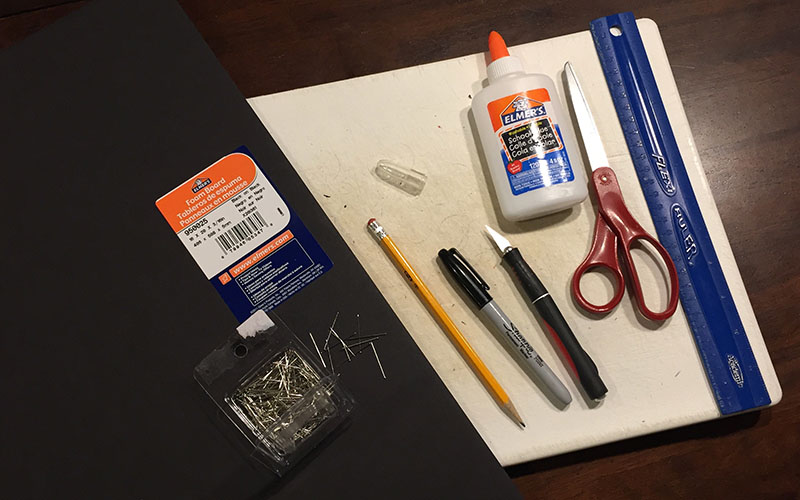
The Prototype
Go Metric System!
Weirdly, I decided to use all metric measurements while I was designing. The box, foam core thickness, and card sizes all measured well using metrics. It took a while to get used to, but the math was SO much easier. Hmmm, why do we use the imperial system still? I digress.
At first, I spent a few hours measuring the box, the cards and tokens. I then started sketching out some design ideas using the best of what I had learned in my research. The metric system made easy math of calculating height and width of the trays.
When I started to feel confident about my direction, I cut out some card stock with the right dimensions and laid them in the box. I’m confident in my math skills, but I’m a very visual and spacial-oriented person so I had to see it first before I started cutting the foam core. It all fit and looked like I expected.
Pieces Needed
The final pieces I needed to make were: (All of these measurements include the thickness of the 5mm foamcore.)
- 1x Main Card Tray – 28cm x 9.5cm x 3.5cm
- 1x Token Tray – 28cm x 9.5cm x 3 cm
- 1x Zombie L Tray / 1x Survivor L Tray – 18cm x 18cm x 3cm (7cm inset x 11cm inset)
- 9x Individual Card Trays – 10cm x 8cm – 2cm
There are actually 13 different types of cards in the game, but I only had space for 12 stacks. Ultimately I decided to put the “Secret” cards under the “Exile” cards in the Main Card Tray. A cheat, admittedly. But once the secret cards are distributed, they are not used so I figured that was an ok compromise.
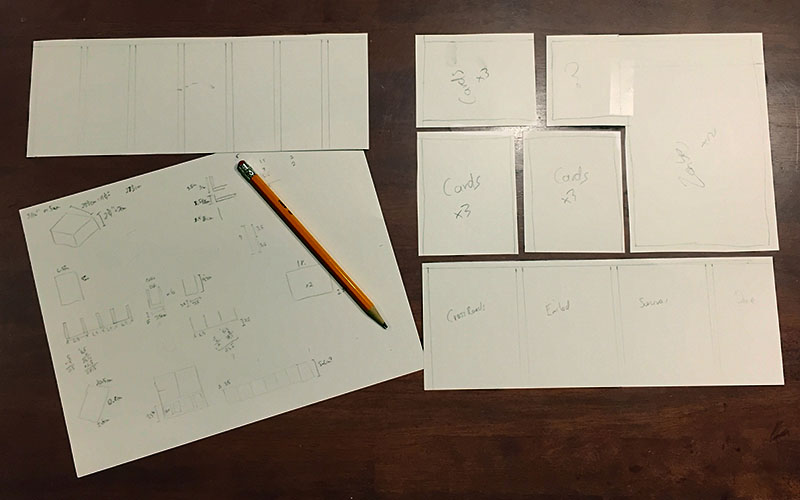
The Build
Carefully, I measured and cut each piece of foam board with as much precision as possible. 5mm tolerance across the entire width of the box didn’t allow much room for error. Although I allowed 5mm of space for the board on top, there wasn’t a lot of vertical tolerance either.
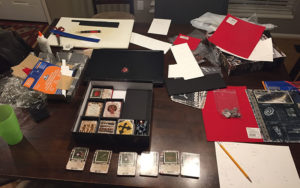
Messy work in progress.
After dry-assembling the pieces, I’d glue them with standard glue, then use straight pins to hold the pieces tightly together. Often, the pins were longer than the piece they were going into, so I would push them in at an angle. This actually made for a stronger bond between pieces. I decided to leave the pins in after the glue dried.
I then measured and cut the red felt to fit in the bottom of each piece. The felt had a paper backing that could be removed, revealing an adhesive surface, which made applying this so much easier.
Then, using a black Sharpie pen, I sketched the symbol for the use of that tray or section. I’m not exactly that kind of artist, so this was tough.
Final Results
I think the new insert turned out great. I am able to go from boxed closed to the entire setup in about 1 minute and 15 seconds. Here are some final pics.

Design and Build Post-Mortem
So after building it, it’s always fun to look back to see what worked in the design and what didn’t. As a whole, I think it turned out exactly as I had hoped. But here are some final notes if were to try it again.
- I wish I had slightly more room for the first player token. It’s a bit tight. This was something I didn’t plan for, and just got lucky that it fit.
- The artwork on the felt is, well, not exactly inspiring. Functional, but not well done. Note to self: take an art class or two… or three.
- I wish I could see the Location Numbers on the trays as I’m unboxing them. Currently, I have to lift the cards to see what location they belong to.
- The cutting, as accurate as I could be, was still not as well done as I had hoped. It is pretty hard to get the blade at exactly 90 degrees when cutting. It really makes you appreciate the precise build of the commercial inserts.
Enjoy!
At the end of the day… it comes down to having less time to set up, faster to start the game, and more time to spend with loved ones. That’s exactly what I intend on doing right now.
